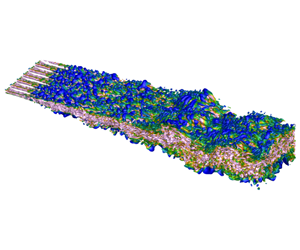Article contents
Numerical investigation of skewed spatially evolving mixing layers
Published online by Cambridge University Press: 19 June 2020
Abstract

The sensitivity of turbulent dynamics in spatially evolving mixing layers to small skew angles  $\unicode[STIX]{x1D703}$ is investigated via direct numerical simulation. Angle
$\unicode[STIX]{x1D703}$ is investigated via direct numerical simulation. Angle  $\unicode[STIX]{x1D703}$ is a measure of the lack of parallelism between the two asymptotic flows, whose interaction creates the turbulent mixing region. The analysis is performed considering a large range of values of the shear intensity parameter
$\unicode[STIX]{x1D703}$ is a measure of the lack of parallelism between the two asymptotic flows, whose interaction creates the turbulent mixing region. The analysis is performed considering a large range of values of the shear intensity parameter  $\unicode[STIX]{x1D6FC}$. This two-dimensional parameter space is explored using the results of a database of 18 direct numerical simulations. Instantaneous fields as well as time-averaged quantities are investigated, highlighting important mechanisms in the emergence of turbulence and its characteristics for this class of flows. In addition, a stochastic approach is used in which
$\unicode[STIX]{x1D6FC}$. This two-dimensional parameter space is explored using the results of a database of 18 direct numerical simulations. Instantaneous fields as well as time-averaged quantities are investigated, highlighting important mechanisms in the emergence of turbulence and its characteristics for this class of flows. In addition, a stochastic approach is used in which  $\unicode[STIX]{x1D703}$ and
$\unicode[STIX]{x1D703}$ and  $\unicode[STIX]{x1D6FC}$ are considered as random variables with a given probability distribution. The response surfaces of flow statistics in the parameter space are built through non-intrusive generalized polynomial chaos. It is found that variations of the parameter
$\unicode[STIX]{x1D6FC}$ are considered as random variables with a given probability distribution. The response surfaces of flow statistics in the parameter space are built through non-intrusive generalized polynomial chaos. It is found that variations of the parameter  $\unicode[STIX]{x1D6FC}$ have a primary effect on the growth of the mixing region. A secondary effect associated with
$\unicode[STIX]{x1D6FC}$ have a primary effect on the growth of the mixing region. A secondary effect associated with  $\unicode[STIX]{x1D703}$ is observed as well. Higher values for the skew angle are responsible for a rapid increase in growth of the inlet structures, enhancing the development of the mixing region. The impact on the turbulence features and, in particular, on the Reynolds stress tensor is also significant. A modification of the normalized diagonal components of the Reynolds stress tensor due to
$\unicode[STIX]{x1D703}$ is observed as well. Higher values for the skew angle are responsible for a rapid increase in growth of the inlet structures, enhancing the development of the mixing region. The impact on the turbulence features and, in particular, on the Reynolds stress tensor is also significant. A modification of the normalized diagonal components of the Reynolds stress tensor due to  $\unicode[STIX]{x1D703}$ is observed. In addition, the interaction between the parameters
$\unicode[STIX]{x1D703}$ is observed. In addition, the interaction between the parameters  $\unicode[STIX]{x1D703}$ and
$\unicode[STIX]{x1D703}$ and  $\unicode[STIX]{x1D6FC}$ is here the governing element.
$\unicode[STIX]{x1D6FC}$ is here the governing element.
JFM classification
- Type
- JFM Papers
- Information
- Copyright
- © The Author(s), 2020. Published by Cambridge University Press
References
- 2
- Cited by


